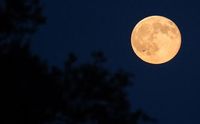On Friday, May 2, 2025, the Moon is in its new phase, marking the beginning of a new lunar cycle. This phase is significant as it sets the stage for the upcoming waxing crescent, which will appear on May 4, 2025, at 10:51 AM. Following that, sky watchers can look forward to a full moon on May 12, 2025, at 1:55 PM, and a waning crescent on May 20, 2025, at 8:58 AM. The cycle will culminate with another new moon on May 27, 2025, at 12:02 AM.
The lunar cycle, also known as lunation, is an astronomical phenomenon that occurs approximately every 29.5 days. This cycle is not only a matter of celestial mechanics but has also been a source of fascination and influence over human activities throughout history. Each of the Moon's phases—new, waxing crescent, full, and waning—lasts about 3.6 days, creating a rhythm that many cultures have historically linked to agricultural practices, emotional states, and even spiritual beliefs.
The new moon is particularly interesting because it occurs when the Moon is positioned between the Earth and the Sun, resulting in the illuminated side of the Moon facing away from us. This makes the Moon virtually invisible in the night sky. As the days progress, a thin crescent of light begins to appear, leading into the waxing crescent phase. This transition is not just a visual spectacle; it symbolizes new beginnings and is often associated with planting and growth in agricultural traditions.
As the Moon waxes, it moves into the first quarter phase, where half of the Moon is illuminated. This phase is followed by the waxing gibbous, where more than half is visible, before reaching the full moon, the most luminous phase. The full moon is a time of celebration in many cultures, often seen as a time of abundance and completion. In contrast, the waning phases—waning gibbous, last quarter, and waning crescent—are associated with reflection and letting go.
The distance from the Moon to Earth is approximately 399,877.13 kilometers, a factor that influences not only its appearance but also the gravitational effects it has on our planet, particularly in the form of ocean tides. These tides are a direct result of the gravitational pull between the Earth and the Moon, demonstrating the profound interconnectedness of celestial bodies.
Interestingly, the appearance of the Moon can differ dramatically depending on the observer's location. For instance, in the Southern Hemisphere, the Moon appears inverted compared to how it looks in the Northern Hemisphere. This means that while a crescent Moon might look like a 'C' shape to someone in the South, it would resemble a 'D' shape to someone in the North. This phenomenon is a reminder of how our perspective shapes our understanding of the universe.
Throughout history, the Moon has captivated human imagination, influencing art, literature, and religion. Many cultures have developed their calendars based on lunar phases. For example, the Islamic calendar is lunar-based, with each month beginning on the new moon. Similarly, the Chinese calendar also follows lunar cycles, which is essential for determining the dates of traditional festivals.
In modern times, the Moon continues to inspire scientists and enthusiasts alike. Research into the Moon's phases has led to a deeper understanding of its role in our solar system and its influence on Earth. Some studies suggest that lunar phases may even affect human behavior, from sleep patterns to mood fluctuations, although this remains a topic of ongoing debate.
As we observe the new moon today, it serves as a reminder of the natural cycles that govern our lives. Whether one is a farmer planning the planting season, a spiritual seeker reflecting on new beginnings, or simply an admirer of the night sky, the Moon's phases offer a connection to the rhythms of nature.
Looking ahead, the waxing crescent on May 4 will invite many to step outside and witness the gradual illumination of our nearest celestial neighbor. This simple act of observing the Moon can evoke a sense of wonder and appreciation for the universe's complexities. So, mark your calendars for the upcoming lunar events and take a moment to enjoy the beauty and significance of the Moon in our lives.

